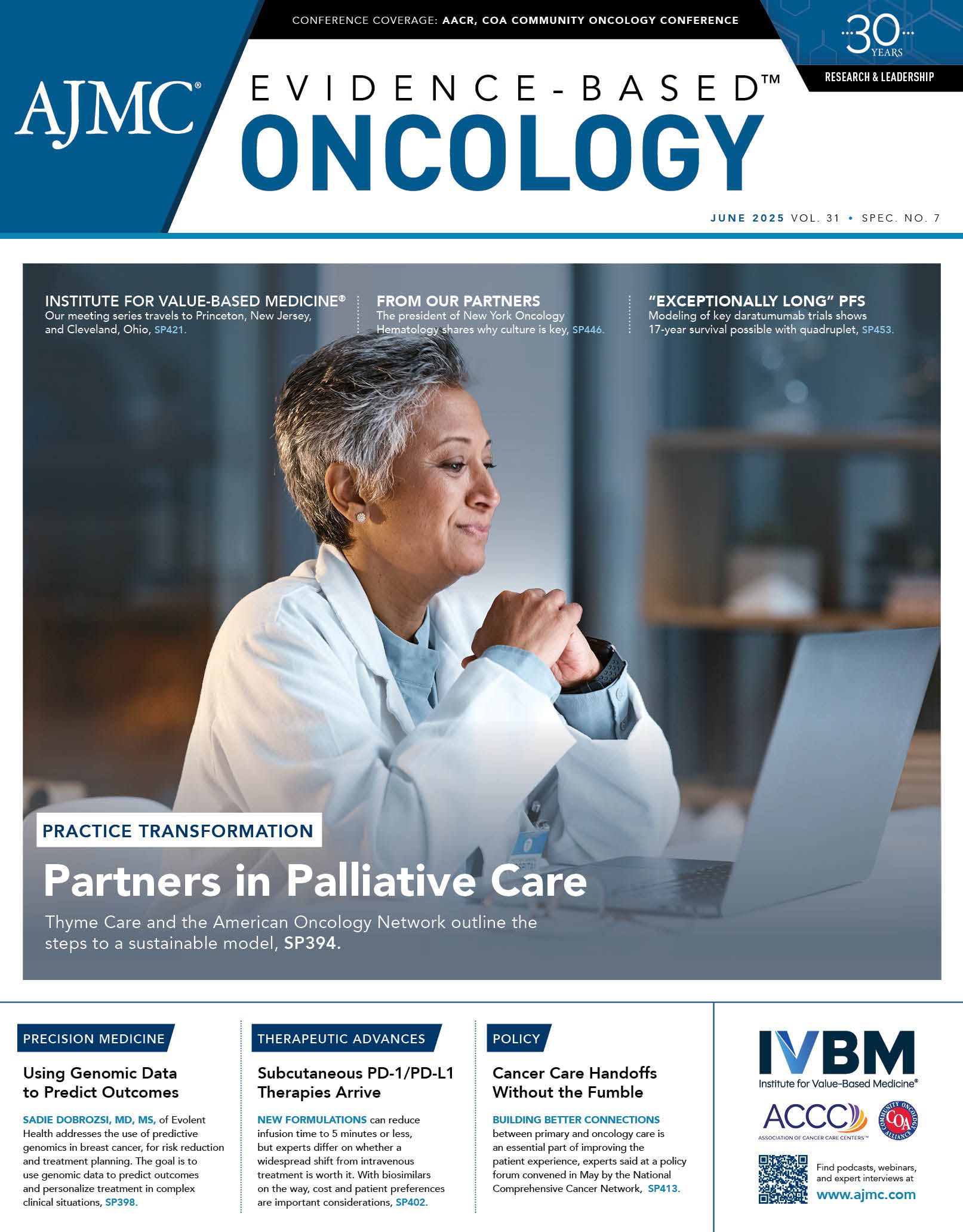- Center on Health Equity & Access
- Clinical
- Health Care Cost
- Health Care Delivery
- Insurance
- Policy
- Technology
- Value-Based Care
Finding the Right Biomarker Is Key to the TIGIT Puzzle, Experts Say
The recent readout of SKYSCRAPER-01 (NCT04294810) filled in details about the phase 3 trial for tiragolumab, an anti-TIGIT antibody, which failed to make a meaningful difference when combined with atezolizumab (Tecentriq, Genentech/Roche) for untreated patients with non–small cell lung cancer (NSCLC).1 At first glance, the results confirm pharma’s current verdict: T-cell immunoreceptor with immunoglobulin and ITIM domain (TIGIT) is a bust as a target for immune checkpoint regulation.
Roche had already pulled back on the SKYSCRAPER program when it announced that SKYSCRAPER-01 missed its primary end point of overall
Solange Peters, MD, PhD | Image: ESMO

Melissa Johnson, MD | Image: SCRI Oncology Partners

Ramaswamy Govindan, MD | Image: WashU

survival (OS) in the final analysis, after missing an earlier end point for progression-free survival (PFS).2 Other companies that have stopped or scaled back research on anti-TIGIT therapies include BeiGene, which halted investment in ociperlimab following a futility analysis, and Merck, which ended development of vibostolimab, including phase 3 studies in lung cancer and melanoma. On May 13, 2025, GSK became the latest pharma giant to drop its TIGIT asset after poor results, ending a $2 billion partnership with iTeos.3
But presenters at the 2025 meeting of the American Association for Cancer Research (AACR) are not ready to write off TIGIT, and neither is Melissa L. Johnson, MD, director of lung cancer research at Sarah Cannon Research Institute (SCRI) in Nashville, Tennessee, who has investigated multiple TIGIT combinations. All insist that scientists have not nailed down the scenarios when targeting how TIGIT works.
SKYSCRAPER-01 compared tiragolumab and the PD-L1 inhibitor atezolizumab with atezolizumab and placebo in untreated patients with advanced, unresectable, or metastatic NSCLC and high PD-L1 expression (≥ 50%); these patients had good performance status and did not have EGFR or ALK alterations. The final data presented in Chicago, Illinois, on April 28, 2025, involved 534 patients randomly assigned 1:1.1
Solange Peters, MD, PhD, professor and chair of medical oncology and thoracic malignancies at the University Hospital of Lausanne, Switzerland, presented the full results for SKYSCRAPER-01 at AACR and noted that the data showed a trend toward a benefit with anti-TIGIT therapy, but fell short of statistical significance.
The combination of tiragolumab and atezolizumab demonstrated a safety profile “perfectly consistent with previous observation of the combination,” she said, adding that “numerical improvements in both this investigator-assessed PFS and overall survival using tiragolumab and atezolizumab vs the control arm suggest potential antitumor activity” of the combination in NSCLC.
Discussant Ramaswamy Govindan, MD, professor of medicine at Washington University in St Louis, explained that SKYSCRAPER-01 is only the most recent phase 3 study involving an anti-TIGIT therapy that failed to confirm findings of earlier, smaller studies. SKYSCRAPER-01 was launched based on results in the phase 2 CITYSCAPE trial (NCT03563716); specifically, an analysis that showed better outcomes for patients with high PD-1 expression.1,4
Johnson, who is also a member of SCRI Oncology Partners, said in an interview with The American Journal of Managed Care® that despite this result, too many trials have shown activity from anti-TIGIT antibodies to dismiss this once-promising protein.
TIGIT can block T-cell activation in different ways: by binding with its ligand, poliovirus receptor (PVR), also called CD155; by disrupting CD226 signaling; or by affecting regulatory T cells (Tregs), in immunosuppression. With multiple mechanisms, there are also multiple possible biomarkers—and scientists say they have not found the one that best predicts when anti-TIGIT therapy will work.
Johnson, an author on SKYSCRAPER-01 and senior author on CITYSCAPE, is deeply familiar with both studies.1,4 “It’s one more piece of information that tells us that we don’t quite have our story straight with TIGIT,” she said. “It’s hard to believe there isn’t something that’s true, because there have been several TIGIT molecules that, when added to PD-1 or PD-L1, have improved outcomes over PD-1 or PD-L1 alone.”
Johnson was also lead author for ARC-7 (NCT04262856), a phase 2 study investigating combinations with 2 novel agents, the anti-TIGIT domvanalimab and dual A2a/A2b antagonist etrumadenant, plus an immunotherapeutic, zimberelimab, in stage IV NSCLC. In January 2023, Johnson presented phase 2 results showing that TIGIT combinations in ARC-10 (NCT04736173) produced a 13% absolute improvement in overall response rate (ORR) and a 40% reduction in risk of disease progression or death.5 Amid all the bad TIGIT news, Gilead and partner Arcus scrapped the phase 3 ARC-10 study, only to see that partial results showed an OS benefit of 36% for the combination, compared with zimberelimab alone.6
What SKYSCRAPER-01 Found
At AACR, Peters reviewed data from the preliminary analysis, with a data cutoff of March 2022, that showed PFS was 7.0 months with tiragolumab vs 5.6 months without, for an HR of 0.78 (95% CI, 0.63-0.97; P = .02). Although this showed a numerical difference favoring the tiragolumab group, the results did not meet the prespecified threshold of P < .01 for significance.1
The final OS analysis was similar: at the time of data cutoff in September 2024, the median OS was 23.1 months with tiragolumab vs 16.9 months without (HR, 0.87; 95% CI, 0.71-1.08; P = .22). Numerical differences favoring the tiragolumab group were also seen in results for ORR (45.8% vs 35.1%) and duration of response (18.0 months vs 14.6 months).1
Peters said despite the failure to meet the primary end point, this was not the end of the story for TIGIT. “I’m convinced that further data are needed to identify the patient population who potentially could benefit from combining an anti–PD-1 or anti–PD-L1 strategy with inhibition of the TIGIT pathway,” she said.
A Different Biomarker?
“I think it’s the biomarker,” said Johnson, when asked what went wrong with SKYSCRAPER-01. CITYSCAPE, she said, had examined multiple possibilities, but that does not mean the options have been exhausted. “We looked at PVR, which is the ligand of TIGIT. We looked at PVRIG (poliovirus receptor–related immunoglobulin domain), which is an associated molecule.
“And there wasn’t anything that bubbled up significantly to a higher extent than PD-1/PD-L1,” she said. “So, PD-L1 became a surrogate.”
When Johnson looks at the SKYSCRAPER-01 and CITYSCAPE data side by side, “the SKYSCRAPER data remind me of the all-comers data from the CITYSCAPE trial…. So, that tells me that selecting based on PD-L1 high, which is how patients were enrolled to SKYSCRAPER-01, didn’t select for the right patients that stood to do better with the addition of [anti]-TIGIT therapy.”
During his presentation, Govindan offered more detail on the mechanisms of the anti-TIGIT approach, as well as several explanations for the discrepancy between CITYSCAPE and SKYSCRAPER-01—the most notable of which is the much larger size of the SKYSCRAPER-01 trial. Elaborating on Peters’ explanation of the mechanism, he said, “TIGIT is an inhibitory molecule, but the critical players here are the CD155 and the CD226, which is the stimulatory molecule,” The activity, or inhibition, of TIGIT affects multiple markers, the dendritic cells, and the Tregs, offering “numerous paths to immune evasion.”
Other results presented at AACR show that biomarkers associated with TIGIT are still being revealed. For example, a late-breaking poster presented by Kevin J. Lee, PhD, of the USA Health Mitchell Cancer Institute in Mobile, Alabama, on behalf of the Deep South Consortium in Oncology, highlighted evidence that the G-protein–coupled receptor 171 (GPR171) may be an “important T-cell checkpoint in tumor immunity.” Using tumor samples in cervical cancer, investigators found that expression of GPR171 was positively correlated with PD-L1, TIGIT expression, CD96, and T-cell–inflamed gene expression profile. Working with Caris Life Sciences, the researchers showed that high expression of GPR171, TIGIT, and CD96 was associated with improved real-world OS and postpembrolizumab survival. At least in cervical cancer, the authors wrote, GPR171 could be “a novel prognostic marker for survival.”7
What Comes Next?
Because PD-1 activation also inhibits CD226, and both PD-1 and TIGIT are expressed in tumor cells, “There is naturally a lot of interest in combining both of them,” Govindan told the attendees at AACR. However, recent results show that much about TIGIT is not fully understood.
There are differences among various TIGIT inhibitors, he said, as well as disagreement over whether these monoclonal antibodies should be engineered to promote or minimize fragment crystallizable receptor (FcR) engagement. Among FcRs, Govindan highlighted a 2024 paper in Nature that examined Fcγ receptors, which bind to the Fc region of antibodies.8
The authors explored the lack of consensus over how tiragolumab improves the PD-L1 blockade. They delved into serum samples and found “a high baseline of intratumoral macrophages and regulatory T cells is associated with better outcomes in patients treated with atezolizumab plus tiragolumab but not with atezolizumab alone.”
The Nature authors further explored TIGIT in experiments with mouse models and wrote that “tiragolumab surrogate antibodies inflamed tumor-associated macrophages, monocytes, and dendritic cells through Fcγ receptors (FcγR), in turn driving antitumor CD8+ T cells from an exhausted effector-like state to a more memory-like state.” This suggests a mechanism in which the TIGIT/checkpoint inhibitor combination can “remodel” a tumor microenvironment that would otherwise allow cancer to grow, indicating a need for FcγR engagement in drug development.7
Govindan concurred with Johnson that more studies are needed to find better biomarkers before concluding they do not work. “I would say that biomarkers that are more agnostic and broad-based are more appropriate,” he said. And perhaps, “We should rethink the combinations with dual inhibition of TIGIT and PD-L1.”
References
1. Peters S, Herbst R, Horinouchi H, et al. SKYSCRAPER-01: a phase III, randomized trial of tiragolumab + atezolizumab versus placebo + atezolizumab in patients with previously untreated PD-L1-high, locally advanced unresectable or metastatic NSCLC. Presented at: American Association for Cancer Research Annual Meeting 2025; April 25-30, 2025; Chicago, IL. Abstract CT051.
2. Roche reports update on phase III SKYSCRAPER-01 results. News release. Roche. November 25, 2024. Accessed May 12, 2025. https://www.roche.com/media/releases/med-cor-2024-11-26
3. LaHucik K. TIGIT graveyard expands as GSK drops late-stage asset with iTeos. Endpoints News. May 13, 2025. Accessed May 13, 2025. https://endpts.com/tigit-graveyard-expands-as-gsk-drops-late-stage-asset-with-iteos
4. Cho BC, Abreu DR, Hussein M, et al. Tiragolumab plus atezolizumab versus placebo plus atezolizumab as a first-line treatment for PD-L1-selected non-small-cell lung cancer (CITYSCAPE): primary and follow-up analyses of a randomised, double-blind, phase 2 study. Lancet Oncol. 2022;23(6):781-792. doi:10.1016/S1470-2045(22)00226-1
5. Helwick C. Anti-TIGIT antibody may boost the benefit of immunotherapy in stage IV lung cancer. The ASCO Post. January 25, 2023. Accessed May 12, 2025. https://ascopost.com/issues/january-25-2023/anti-tigit-antibody-may-boost-the-benefit-of-immunotherapy-in-stage-iv-lung-cancer
6. Conroy R. Domvanalimab combo improves survival in advanced/metastatic NSCLC. CancerNetwork®. November 6, 2024. Accessed May 12, 2025. https://www.cancernetwork.com/view/domvanalimab-combo-improves-survival-in-advanced-metastatic-nsclc
7. Joshi T, Murphy E, Sagar C, et al. GPR171, a prognostic marker of improved survival in cervix cancer: a Deep South Consortium in Oncology (DSCO) Project. Presented at: American Association for Cancer Research Annual Meeting 2025; April 25-30, 2025; Chicago, IL. Abstract LB261.
8. Guan X, Hu R, Choi Y, et al. Anti-TIGIT antibody improves PD-L1 blockade through myeloid and Treg cells. Nature. 2024;627(8004):646-655. doi:10.1038/s41586-024-07121-9

The Importance of Examining and Preventing Atrial Fibrillation
August 29th 2023At this year’s American Society for Preventive Cardiology Congress on CVD Prevention, Emelia J. Benjamin, MD, ScM, delivered the Honorary Fellow Award Lecture, “The Imperative to Focus on the Prevention of Atrial Fibrillation,” as the recipient of this year’s Honorary Fellow of the American Society for Preventive Cardiology award.
Listen
Promoting Equity in Public Health: Policy, Investment, and Community Engagement Solutions
June 28th 2022On this episode of Managed Care Cast, we speak with Georges C. Benjamin, MD, executive director of the American Public Health Association, on the core takeaways of his keynote session at AHIP 2022 on public health policy and other solutions to promote equitable health and well-being.
Listen
